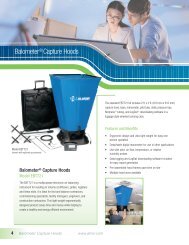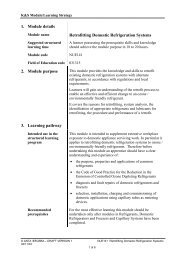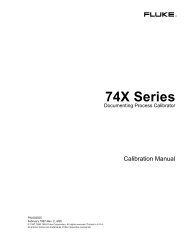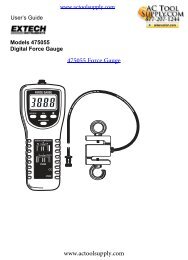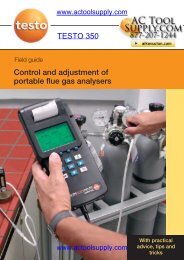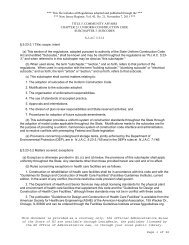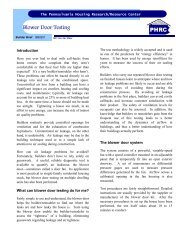Megger MIT400-EN Testing Guide - Actoolsupply.com
Megger MIT400-EN Testing Guide - Actoolsupply.com
Megger MIT400-EN Testing Guide - Actoolsupply.com
- No tags were found...
Create successful ePaper yourself
Turn your PDF publications into a flip-book with our unique Google optimized e-Paper software.
www.actoolsupply.<strong>com</strong>“A Stitch in Time...”US $9.95GBP £5.95The Complete<strong>Guide</strong> to ElectricalInsulation <strong>Testing</strong>www.actoolsupply.<strong>com</strong>
www.actoolsupply.<strong>com</strong>“A Stitch In Time”The Complete <strong>Guide</strong> toElectrical Insulation <strong>Testing</strong>Copyright 2006www.actoolsupply.<strong>com</strong>STITCH IN TIME
ContentsPageWHAT IS “Good” insulation?......................................................................... 3WHAT Makes Insulation Go Bad?................................................................ 4How Insulation Resistance is Measured................................................... 5How to Interpret Resistance Readings..................................................... 6FACTORS AFFECTING INSULATION RESISTANCE READINGS.............................. 8Types of Insulation Resistance Tests....................................................... 10test Voltage vs. Equipment Rating.......................................................... 16AC <strong>Testing</strong> vs. DC............................................................................................ 17USE OF DC DIELECTRIC TEST SET....................................................................... 18TESTS DURING DRYING OUT OF EQUIPM<strong>EN</strong>T.................................................. 18EFFECT OF TEMPERATURE ON insulation Resistance................................ 21Effects of humidity...................................................................................... 23PREPARATIOn of Apparatus to test........................................................... 24Safety Precautions....................................................................................... 26Connections for testing insulation resistance ofelectrical equipment................................................................................... 27Additional Notes About using A <strong>Megger</strong> Insulation Tester............ 33InTERPRETATIOn-Minimum Values............................................................... 36Minimum Values for Insulation Resistance.......................................... 38Tests Using Multi-Voltage <strong>Megger</strong> Insulation Testers...................... 42Step-Voltage Method................................................................................... 48Use of a Guard Terminal............................................................................ 50Bushings, Potheads and Insulators........................................................ 54Outdoor Oil Circuit Breakers................................................................... 57Setting up a Maintenance program........................................................ 60How Often Should You Test?.................................................................... 60MEGGER 5 AND 10 KV INSULATION TESTERS.................................................. 62MEGGER 1 KV INSULATION TESTERS................................................................ 64www.actoolsupply.<strong>com</strong>WHAT IS “Good” insulation?Every electric wire in your plant – whether it’s in a motor, generator, cable,switch, transformer, etc. – is carefully covered with some form of electricalinsulation. The wire itself is usually copper or aluminum, which is known tobe a good conductor of the electric current that powers your equipment. Theinsulation must be just the opposite from a conductor: it should resist currentand keep the current in its path along the conductor.To understand insulation testing you really don’t need to go into themathematics of electricity, but one simple equation – Ohm’s law – can be veryhelpful in appreciating many aspects. Even if you’ve been exposed to this lawbefore, it may be a good idea to review it in the light of insulation testing.The purpose of insulation around a conductor is much like that of a pipecarrying water, and Ohm’s law of electricity can be more easily understood bya <strong>com</strong>parison with water flow. In Fig. 1 we show this <strong>com</strong>parison. Pressure onwater from a pump causes flow along the pipe (Fig. 1a). If the pipe were tospring a leak, you’d waste water and lose some water pressure.With electricity, voltage is like the pump pressure, causing electricity to flowalong the copper wire (Fig. 1b). As in a water pipe, there is some resistanceto flow, but it is much less along the wire than it is through the insulation.Figure 1–Comparison of water flow (a) with electric current (b). A STITCH IN TIME A STITCH IN TIME www.actoolsupply.<strong>com</strong>
Common sense tells us that the more voltage we have, the more currentthere’ll be. Also, the lower the resistance of the wire, the more current forthe same voltage.Actually, this is Ohm’s law, which is expressed this way in equation form:where,E = I x RE = voltage in voltsI = current in amperesR = resistance in ohmsNote, however, that no insulation is perfect (that is, has infinite resistance) sosome electricity does flow along the insulation or through it to ground. Sucha current may only be a millionth of an ampere (one microampere) but it isthe basis of insulation testing equipment. Note also that a higher voltagetends to cause more current through the insulation. This small amount ofcurrent would not, of course, harm good insulation but would be a problemif the insulation has deteriorated.Now, to sum up our answer to the question “what is ‘good’ insulation?”We have seen that, essentially, “good” means a relatively high resistanceto current. Used to describe an insulation material, “good” would alsomean “the ability to keep a high resistance.” So, a suitable way ofmeasuring resistance can tell you how “good” the insulation is. Also, if youtake measurements at regular periods, you can check trends toward itsdeterioration (more on this later).What Makes Insulation Go Bad?When your plant electrical system and equipment are new, the electricalinsulation should be in top notch shape. Furthermore, manufacturers of wire,cable, motors, and so on have continually improved their insulations forservices in industry. Nevertheless, even today, insulation is subject to manyeffects which can cause it to fail – mechanical damage, vibration, excessiveheat or cold, dirt, oil, corrosive vapors, moisture from processes, or just thehumidity on a muggy day.www.actoolsupply.<strong>com</strong>Once started, the different enemies tend to aid each other, permittingexcessive current through the insulation.Sometimes the drop in insulation resistance is sudden, as when equipmentis flooded. Usually, however, it drops gradually, giving plenty of warning,if checked periodically. Such checks permit planned reconditioning beforeservice failure. If there are no checks, a motor with poor insulation, forexample, may not only be dangerous to touch when voltage is applied,but also be subject to burn out. What was good insulation has be<strong>com</strong>e apartial conductor.How Insulation Resistance is MeasuredYou have seen that good insulation has high resistance; poor insulation,relatively low resistance. The actual resistance values can be higher or lower,depending upon such factors as the temperature or moisture content of theinsulation (resistance decreases in temperature or moisture). With a littlerecord-keeping and <strong>com</strong>mon sense, however, you can get a good picture ofthe insulation condition from values that are only relative.The <strong>Megger</strong> insulation tester is a small, portable instrument that gives youa direct reading of insulation resistance in ohms or megohms. For goodinsulation, the resistance usually reads in the megohm range.The <strong>Megger</strong> insulation tester is essentially a high-range resistance meter(ohmmeter) with a built-in direct-current generator. This meter is of specialconstruction with both current and voltage coils, enabling true ohms to beread directly, independent of the actual voltage applied. This method is nondestructive;that is, it does not cause deterioration of the insulation.In various degrees, these enemies of insulation are at work as time goeson – <strong>com</strong>bined with the electrical stresses that exist. As pin holes or cracksdevelop, moisture and foreign matter penetrate the surfaces of theinsulation, providing a low resistance path for leakage current.Figure 2–Typical <strong>Megger</strong> test instrument hook-up to measure insulation resistance. A STITCH IN TIME A STITCH IN TIME www.actoolsupply.<strong>com</strong>
The generator can be hand-cranked or line-operated to develop a highDC voltage which causes a small current through and over surfaces of theinsulation being tested (Fig. 2). This current (usually at an applied voltageof 500 volts or more) is measured by the ohmmeter, which has an indicatingscale. Fig. 3 shows a typical scale, which reads increasing resistance valuesfrom left up to infinity, or a resistance too high to be measured.www.actoolsupply.<strong>com</strong>Whether you test monthly, twice a year, or once a year depends upon thetype, location, and importance of the equipment. For example, a smallpump motor or a short control cable may be vital to a process in your plant.Experience is the best teacher in setting up the scheduled periods for yourequipment.You should make these periodic tests in the same way each time. That is,with the same test connections and with the same test voltage applied forthe same length of time. Also you should make tests at about the sametemperature, or correct them to the same temperature. A record of therelative humidity near the equipment at the time of the test is also helpfulin evaluating the reading and trend. Later sections cover temperaturecorrection and humidity effects.Figure 3–Typical scale on the <strong>Megger</strong> insulation tester.In summary, here are some general observations about how you can interpretperiodic insulation resistance tests, and what you should do with the result:How to Interpret Resistance ReadingsAs previously mentioned, insulation resistance readings should be consideredrelative. They can be quite different for one motor or machine tested threedays in a row, yet not mean bad insulation. What really matters is the trendin readings over a time period, showing lessening resistance and warningof <strong>com</strong>ing problems. Periodic testing is, therefore, your best approach topreventive maintenance of electrical equipment, using record cards as shownin Fig. 4.Condition(a) Fair to high valuesand well maintained.(b) Fair to high values,but showing aconstant tendencytowards lower values.(c) Low but well maintained.What To Dono cause for concern.locate and remedy the cause andcheck the downward trend.Condition is probably all right, butcause of low values should bechecked.Figure 4–Typical record of insulation resistance of a mill motor. Curve A shows test values asmeasured; Curve B shows same values corrected to 20°C (see page 22), giving a definite downwardtrend toward an unsafe condition. Reverse side of card (at right) is used to record the test data.(d) So low as to be unsafe.(e) Fair or high values,previously wellmaintained but showingsudden lowering.Clean, dry out, or otherwise raise thevalues before placing equipment inservice. (Test wet equipment whiledrying out.)Make tests at frequent intervals untilthe cause of low values is locatedand remedied; or until the valueshave be<strong>com</strong>e steady at a lowerlevel but safe for operation; or untilvalues be<strong>com</strong>e so low that it is unsafeto keep the equipment in operation. A STITCH IN TIME A STITCH IN TIME www.actoolsupply.<strong>com</strong>
FACTORS AFFECTING INSULATION RESISTANCE READINGSRemember that the measured resistance (of the insulation) will bedetermined by the voltage applied and the resultant current (R = E/I).There are a number of things that affect current, including temperatureof the insulation and humidity, as mentioned in the previous section.Right now, let’s just consider the nature of current through insulationand the effect of how long voltage is applied.Current through and along insulation is made up partly of a relativelysteady current in leakage paths over the insulation surface. Electricityalso flows through the volume of the insulation. Actually, as shown inFig. 5, our total current <strong>com</strong>prises three <strong>com</strong>ponents:1. Capacitance Charging CurrentCurrent that starts out high and drops after the insulation has beencharged to full voltage (much like water flow in a garden hose whenyou first turn on the spigot).www.actoolsupply.<strong>com</strong>2. Absorption CurrentAlso an initially high current which then drops (for reasons discussedunder the section Time-Resistance Method).3. Conduction or Leakage CurrentA small essentially steady current both through and over theinsulation.As shown in Fig. 5, the total current is the sum of the three <strong>com</strong>ponentsand it is this current that can be measured directly by a microammeter,or in terms of megohms at a particular voltage by means of a <strong>Megger</strong>instrument (ohmmeter). Because the total current depends upon thetime that the voltage is applied, you can see now why Ohm’s Law R = E/Ionly holds, theoretically, at an infinite time (that is, you’d have to waitforever before taking a reading).In practice, as you will see in the test methods described below, youread a value that is the apparent resistance – a useful value to diagnosetroubles, which is what you want to do.Figure 5–Curves showing <strong>com</strong>ponents of current measured during DC testing of insulation.Note also in Fig. 5 that the charging current disappears relatively rapidlyas the equipment under test be<strong>com</strong>es charged. Larger units with morecapacitance will take longer to be charged. This current also is the storedenergy initially discharged after your test, by short-circuiting and groundingthe insulation. ALWAYS TAKE THIS SAFETY MEASURE.You can see further from Fig. 5 that the absorption current decreases at arelatively slow rate, depending upon the exact nature of the insulation. Thisstored energy, too, must be released at the end of a test, and requires alonger time than the capacitance charging current – about four times as longas the voltage was applied.With good insulation, the conduction or leakage current should build up to asteady value that is constant for the applied voltage, as shown in Fig. 5. Anyincrease of leakage current with time is a warning of trouble, as discussed inthe tests described in the following section. A STITCH IN TIME A STITCH IN TIME www.actoolsupply.<strong>com</strong>
With a background now of how time affects the meaning of instrumentreadings, let’s consider three <strong>com</strong>mon test methods: (1) short-time or spotreading; (2) time-resistance; and (3) step or multi-voltage tests.Types of Insulation Resistance TestsShort-Time or Spot-Reading TestIn this method, you simply connect the <strong>Megger</strong> instrument across theinsulation to be tested and operate it for a short, specific time period(60 seconds is usually re<strong>com</strong>mended). As shown schematically in Fig. 6,you’ve simply picked a point on a curve of increasing resistance values;quite often the value would be less for 30 seconds, more for 60 seconds.Bear in mind also that temperature and humidity, as well as condition ofyour insulation affect your reading.www.actoolsupply.<strong>com</strong>If the apparatus you are testing has very small capacitance, such as ashort run of house wiring, the spot reading test is all that is necessary.However, most equipment is capacitive and so your very first spot readingon equipment in your plant, with no prior tests, can be only a rough guideas to how good or bad the insulation is. For many years, maintenanceprofessionals have used the one-megohm rule to establish the allowablelower limit for insulation resistance. The rule may be stated:Insulation resistance should be approximately one megohm for each 1,000volts of operating voltage, with a minimum value of one megohm.For example, a motor rated at 2,400 volts should have a minimum insulationresistance of 2.4 megohms. In practice, megohm readings normally areconsiderably above this minimum value in new equipment or wheninsulation is in good condition.By taking readings periodically and recording them, you have a better basisof judging the actual insulation condition. Any persistent downward trendis usually fair warning of trouble ahead, even though the readings may behigher than the suggested minimum safe values. Equally true, as long asyour periodic readings are consistent, they may be ok, even though lowerthan the re<strong>com</strong>mended minimum values. The curves of Fig. 7 show typicalbehavior of insulation resistance under varying plant operating conditions.The curves were plotted from spot readings taken with a <strong>Megger</strong> instrumentover a period of months.Figure 6–Typical curve of insulation resistance (in megohms) with time for the “short time” or“spot-reading” test method.10 A STITCH IN TIME A STITCH IN TIME 11www.actoolsupply.<strong>com</strong>
www.actoolsupply.<strong>com</strong>Time-Resistance MethodThis method is fairly independent of temperature and often can giveyou conclusive information without records of past tests. It is based onthe absorption effect of good insulation <strong>com</strong>pared to that of moist orcontaminated insulation. You simply take successive readings at specific timesand note the differences in readings (see curves, Fig. 8). Tests by this methodare sometimes referred to as absorption tests.Note that good insulation shows a continual increase in resistance (lesscurrent – see curve A) over a period of time (in the order of 5 to 10 minutes).This is caused by the absorption current we spoke of earlier; good insulationshows this charge effect over a time period much longer than the timerequired to charge the capacitance of the insulation.If the insulation contains much moisture or contaminants, the absorptioneffect is masked by a high leakage current which stays at a fairly constantvalue, keeping the resistance reading low (remember: R = E/I).Figure 8–Typical curves showing dielectric absorption effect in a “time-resistance” test, made oncapacitive equipment such as a large motor winding.Figure 7–Typical behavior of insulation resistance over a period of months under varying operatingconditions, (curves plotted from spot readings with a <strong>Megger</strong> instrument).The time-resistance test is of value also because it is independent ofequipment size. The increase in resistance for clean and dry insulation occursin the same manner whether a motor is large or small. You can, therefore,<strong>com</strong>pare several motors and establish standards for new ones, regardless oftheir horsepower ratings.12 A STITCH IN TIME A STITCH IN TIME 13www.actoolsupply.<strong>com</strong>
Fig. 9 shows how a 60-second test would appear for good and perhaps badinsulation. When the insulation is in good shape, the 60-second reading ishigher than the 30-second reading.www.actoolsupply.<strong>com</strong>Dielectric Absorption RatioThe ratio of two time-resistance readings (such as a 60-second readingdivided by a 30-second reading) is called a dielectric absorption ratio. It isuseful in recording information about insulation. If the ratio is a 10-minutereading divided by a 1-minute reading, the value is called the polarizationindex.With hand-cranked <strong>Megger</strong> instruments, it’s a lot easier for you to run thetest for only 60 seconds, taking your first reading at 30 seconds. If you have aline-operated <strong>Megger</strong> instrument, you’ll get best results by running the test10 minutes, taking readings at 1- and at 10-minutes, to get the polarizationindex. Table I gives values of the ratios and corresponding relativeconditions of the insulation that they indicate.TABLE I—Condition of Insulation Indicated byDielectric Absorption Ratios*Figure 9–Typical card plot of a time-resistance or double-reading test.A further advantage of this double-reading test, as it is sometimes called,is that it gives you a clearer picture, even when a spot reading says theinsulation looks fine.For example, let’s say the spot reading on a synchronous motor was 10megohms. Now, let’s assume that the double-reading check shows that theinsulation resistance holds steady at 10 megohms while you hold voltage upto 60 seconds. This means there may be dirt or moisture in the windings thatbears watching. On the other hand, if the pointer shows a gradual increasebetween the 30-second and the 60-second checks, then you’re reasonablysure the windings are in good shape.Time-resistance tests on large rotating electrical machinery – especially withhigh operating voltage – require high insulation resistance ranges and a veryconstant test voltage. A heavy-duty <strong>Megger</strong> test set, line-operated, servesthis need. Similarly, such an instrument is better adapted for large cables,bushings, transformers and switchgear.InSUlATIOnCOndITIOndangerousquestionableGoodExcellent60/30-SECOndRATIO—1.0 to 1.251.4 to 1.6Above 1.6**10/1-MInUTE RATIO(POlARIZATIOn IndEX)less than 11.0 to 2***2 to 4Above 4***These values must be considered tentative and relative—subject to experience with the time-resistance methodover a period of time.**In some cases, with motors, values approximately 20%higher than shown here indicate a dry brittle windingwhich will fail under shock conditions or during starts. Forpreventive maintenance, the motor winding should becleaned,treated, and dried to restore winding flexibility.***These results would be satisfactory for equipment withvery low capacitance such as short runs of house wiring.14 A STITCH IN TIME A STITCH IN TIME 15www.actoolsupply.<strong>com</strong>
test Voltage vs. Equipment RatingCommonly used DC test voltages for routine maintenance are as follows:Equipment AC Rating DC Test Voltageup to 100 volts100 and 250 volts440 to 550 volts 500 and 1,000 volts2,400 volts 1,000 to 2,500 voltsor higher4,160 volts and above 1,000 to 5,000 volts,or higherTest voltages used for proof testing of equipment are considerably higherthan those used for routine maintenance. Although there are no publishedindustry standards for DC maximum proof test voltages to be used withrotating equipment, the schedule given below is customarily used. Forspecific re<strong>com</strong>mendations on your equipment, you should consult themanufacturer of the equipment.Proof Test Voltages for Rotating Equipment:Factory AC Test = 2 x Nameplate Rating + 1000 voltsDC Proof Test on Installation = 0.8 x Factory AC Test x 1.6DC Proof Test After Service = 0.6 x Factory AC Test x 1.6Example:Motor with 2,400 VAC nameplate rating–Factory AC Test = 2(2,400) +1,000 = 5,800 VACMax. DC Test on Installation = 0.8(5,800)1.6 = 7,424 VDCMax. DC Test After Service = 0.6(5,800)1.6 = 5,568 VDCwww.actoolsupply.<strong>com</strong>AC <strong>Testing</strong> vs. DCUp to now, we’ve talked about testing with DC voltage, but you will hearof AC testing and need to know the difference. Remember that we spokeof the kinds of current produced in insulation by DC? (The initial surge ofcharging current, the drop with time to absorption current, and then, aftermore time, the steady conduction current.) We saw that in insulation testing,the conduction or leakage current is the one that gives us the informationwe need.In contrast, testing with AC gives a charging current that is extremelylarge <strong>com</strong>pared to the other kinds; leakage current is relatively minor. ACfrequently is used for high-potential testing; voltage is increased to somespecified point to see if the insulation can stand that particular voltage. Itis a GO/NO-GO type of test and can cause deterioration of the insulation, incontrast to the DC test which is basically non-destructive.If an AC test voltage has been used and you want to use DC tests asan alternative, you will need to increase the maximum DC test voltagesomewhat to obtain equivalent results.In some cases, AC testing may be more suitable for proof testing ofequipment (that is, seeing that the equipment meets prescribed standards).You run the voltage up to the selected value and the equipment eitherpasses or doesn’t pass the test. With the DC test, you get a more qualitativepicture; you can meter the leakage current as you increase the voltage andobtain specific values of insulation resistance.As the size of your equipment increases, there are also marked economicadvantages in DC over AC testing. As the test voltage increases, both thecost and weight of AC equipment go up much faster than with <strong>com</strong>parableDC test equipment. This is because the AC test set must supply the chargingcurrent which be<strong>com</strong>es and remains very high in the larger machines. Asexplained previously, in DC testing, this current drops rapidly after the initialcharging period.16 A STITCH IN TIME A STITCH IN TIME 17www.actoolsupply.<strong>com</strong>
In summary, DC test sets are employed almost exclusively for high-voltagemaintenance and field testing for the following reasons:1. lower cost2. Lighter weight3. Smaller size4. Non-destructive5. Better information, both in quality and quantityUSE OF DC DIELECTRIC TEST SETThe <strong>Megger</strong> instrument, reading directly in ohms and megohms ofinsulation resistance, is your best bet for routine in-plant maintenance.However, some plants, particularly with higher voltage ratings in equipment,use another <strong>Megger</strong> product – the dielectric test set. So, you should beaware of this instrument and its use in insulation resistance measurements.The dielectric test set can be used to determine insulation resistance by thesame test methods as outlined for the <strong>Megger</strong> instrument; that is, the shorttime,time-resistance and step-voltage tests. It is designed for other uses, too,but for insulation testing it provides: (1) an adjustable output voltage and(2) a monitoring of the resultant current in micro-amperes. The <strong>Megger</strong> DCDielectric Test Sets are available with voltage outputs ranging from 5 kV upto 160 kV.The curves of Fig. 5 are plotted as current versus time, as are curves forinsulation measurements on typical equipment given near the end of thismanual. <strong>Megger</strong> supplies graph paper which makes it easy to plot megohmsof insulation resistance from your voltage and current readings.TESTS DURING DRYING OUT OF EQUIPM<strong>EN</strong>TWet electrical equipment is a <strong>com</strong>mon hazard faced by all maintenanceengineers. If the equipment is wet from fresh water, you go right aheaddrying it out. However, if you’ve got salt water, you must first wash away thesalt with fresh water. Otherwise, you’ll leave very corrosive deposits of salton metal and insulating surfaces as well as in crevices of the insulation. Withmoisture, such deposits form a very good conductor of electricity. Also, youshould remove oil or grease from the insulation, using a suitable solvent.www.actoolsupply.<strong>com</strong>There are various ways to dry out electrical equipment, depending uponits size and portability. You can use a blast of hot air, an oven, circulationof current through conductors, or a <strong>com</strong>bination of techniques. Local plantconditions and facilities, together with information from the equipmentmanufacturers, can serve as a guide to the best method for your particularequipment.In some cases, or with certain equipment, drying out may not be necessary.You can check this by insulation resistance tests, if you have records ofprevious tests on the apparatus. When drying out is required, such recordsare also helpful to determine when the insulation is free of moisture.NOTE: Wet equipment is susceptible to voltage breakdown. Therefore, youshould use a low-voltage <strong>Megger</strong> tester (100 or 250 VDC), at leastin the early stages of a drying-out run. If a low-voltage instrumentis not readily available, slow cranking of a 500-volt tester may besubstituted.Many testers have an additional test range measuring in kilohms(kW). This measurement is typically made at only a few volts, andis the ideal initial measurement to be made on flooded equipment.This range measures below the Megohm range, and can, therefore,provide an actual measurement to use as a benchmark in monitoringthe drying process. If a kilohm measurement is obtained, insulationhas been thoroughly saturated, but may be reclaimable. Alternatelytest and dry, watching the readings rise until they reach the Megohmrange, at which time higher voltage tests can be safely employed.As an example of how important past readings are, let’s look at a 100-hpmotor that’s been flooded. After a clean-up, a spot reading with the <strong>Megger</strong>tester shows 1.5 megohms. Offhand, you’d probably say this is ok. What’smore, if past records showed the insulation resistance to run between 1 and2 megohms, you’d be sure.On the other hand, if past records showed the normal resistance values torun 10 or 20 megohms, then you would know that water was still in themotor windings.18 A STITCH IN TIME A STITCH IN TIME 19www.actoolsupply.<strong>com</strong>
www.actoolsupply.<strong>com</strong>EFFECT OF TEMPERATURE ON insulation ResistanceThe resistance of insulating materials decreases markedly with an increase intemperature. As we’ve seen, however, tests by the time-resistance and stepvoltagemethods are relatively independent of temperature effects, givingrelative values.If you want to make reliable <strong>com</strong>parisons between readings, you shouldcorrect the readings to a base temperature, such as 20°C, or take all yourreadings at approximately the same temperature (usually not difficult to do).We will cover some general guides to temperature correction.One thumb rule is:For every 10°C increase in temperature,halve the resistance;or, for every 10°C decrease,double the resistance.For example, a two-megohm resistance at 20°C reduces to 1 / 2megohmat 40°C.Figure 10-Typical drying curve where one-minute readings of insulation resistance are taken everyfour hours.The typical drying-out curve for a DC motor armature (Fig. 10) shows howinsulation resistance changes. During the first part of the run, the resistanceactually decreases because of the higher temperature. Then it rises at aconstant temperature as drying proceeds. Finally, it rises to a high value, asroom temperature (20°C) is reached.Note that if you conduct insulation resistance tests during drying, and youhave readings of previous tests on the dry equipment, you’ll know whenyou’ve reached the safe value for the unit. You may prefer to use a timeresistancetest, taken periodically (say, once a shift), using the dielectricabsorption ratio or polarization index to follow dry-out progress (no need tocorrect for temperature).Each type of insulating material will have a different degree of resistancechange with temperature. Factors have been developed, however, tosimplify the correction of resistance values. Table II gives such factors forrotating equipment, transformers and cable. You multiply the readings youget by the factor corresponding to the temperature (which you need tomeasure).For example, assume you have a motor with Class A insulation and you get areading of 2.0 megohms at a temperature (in the windings) of 104°F (40°C).From Table II you read across at 104°F to the next column (for Class A) andobtain the factor 4.80. Your corrected value of resistance is then:2.0 megohms x 4.80 = 9.6 megohms(reading (correction (correctedat 104°F) factor for reading forClass A 68°F or 20°C)insulationat 104°F)20 A STITCH IN TIME A STITCH IN TIME 21www.actoolsupply.<strong>com</strong>
Note that the resistance is almost five times greater at 68°F (20°C), as<strong>com</strong>pared to the reading taken at 104°F. The reference temperature forcable is given as 60°F (15.6°C), but the important point is to be consistentand correct to the same base.TABLE II-Temperature Correction Factors*www.actoolsupply.<strong>com</strong>TEMP.ROTATInGEqUIP.CABlES°C°FClASS AClASS BOIl-FIllEdTRAnSFORMERSCOdEnATURAlCOdEGR-SPERFORMAnCEnATURAlHEAT RESIST.nATURAlHEAT RESIST. &PERFORM. GR-SOZOnE RESIST.nATURAl GR-SVARnISHEdCAMBRICIMPREGnATEdPAPER051015.6324150600.210.310.450.710.400.500.630.810.250.360.500.740.250.400.611.000.120.230.461.000.470.600.761.000.420.560.731.000.220.370.581.000.140.260.491.000.100.200.431.000.280.430.641.0020253035687786951.001.482.203.241.001.251.582.001.001.401.982.801.472.273.525.451.833.677.3214.601.241.582.002.551.281.682.242.931.532.484.036.531.753.296.2011.651.944.088.6218.201.432.173.204.77404550551041131221314.807.1010.4515.502.503.153.985.003.955.607.8511.208.4513.1020.0029.2054.00116.003.264.155.296.723.855.086.728.8310.7017.1027.8545.0025.0041.4078.0038.5081.00170.00345.007.1510.7016.0024.006065707514014915816722.8034.0050.0074.006.307.9010.0012.6015.8522.4031.7544.708.58 11.62 73.0015.40 118.0020.30 193.0026.60 313.00*Corrected to 20° C for rotating equipment and transformers; 15.6° C for cable.775.00 36.00Nomograph of temperature correction values for <strong>Megger</strong> readings(corrected to 25°C). For rotating machinery with Class B insulation.Effects of humidityWe have spoken at various points in this manual about the presence ofmoisture in insulation and its very marked effect upon resistance values. Youmight expect, therefore, that increasing humidity (moisture content) in thesurrounding (ambient) air could affect insulation resistance. And it can tovarying degrees.If your equipment operates regularly above the dew-point temperature (thetemperature at which the moisture vapor in air condenses as a liquid), thetest reading normally will not be affected much by the humidity. Even if theequipment to be tested is idle, the same is true – so long as its temperature iskept above the dew point.22 A STITCH IN TIME A STITCH IN TIME 23www.actoolsupply.<strong>com</strong>
The aforementioned statement assumes that the insulation surfacesare free of contaminants, such as certain lints and acids or salts,which have the property of absorbing moisture (they’re called“hygroscopic” or “deliquescent” materials by chemists). Theirpresence could unpredictably affect your readings; they should beremoved before tests are made.In electrical equipment we’re concerned primarily with the conditions onthe exposed surfaces where moisture condenses and affects the overallresistance of the insulation. Studies show, however, that dew will form in thecracks and crevices of insulation before it is visibly evident on the surface.Dew-point measurements will give you a clue as to whether such invisibleconditions might exist, altering the test results.As a part of your maintenance records, therefore, it’s a good idea to makenote at least of whether the surrounding air was dry or humid when thetest was made. Also, whether the temperature was above or below theambient. When you test vital equipment, record the ambient wet and drybulb temperatures, from which dew-point and percent relative or absolutehumidity can be obtained.Preparation of Apparatus to test1. Take Out of ServiceShut down the apparatus. Open switches. De-energize. Disconnect fromother equipment and circuits, including neutral and protective (workmen’stemporary) ground connections. See Safety Precautions, page 26.2. Make Sure Just What is Included in the TestInspect the installation very carefully to determine just what equipmentis connected and will be included in the test, especially if it is difficult orexpensive to disconnect associated apparatus and circuits. Pay particularattention to conductors that lead away from the installation. This is veryimportant, because the more equipment that is included in a test, the lowerthe reading will be, and the true insulation resistance of the apparatus inquestion may be masked by that of the associated equipment.It is always possible, of course, that the insulation resistance of the <strong>com</strong>pleteinstallation (without disconnecting everything) will be satisfactorily high,especially for a spot check. Or, it may be higher than the range of thewww.actoolsupply.<strong>com</strong><strong>Megger</strong> instrument in use, in which case nothing would be gained byseparating the <strong>com</strong>ponents, because the insulation resistance of each partwould be still higher.For an initial test, it may be necessary to separate the <strong>com</strong>ponent parts, eventhough labor and expense are involved, and test each one separately. Alsomake a test of all the <strong>com</strong>ponents connected together. With this informationon record, it may not be necessary to separate the <strong>com</strong>ponents on futuretests unless unaccountably low readings are observed.3. Discharge of CapacitanceIt is very important that capacitance be discharged, both before and afteran insulation resistance test. It should be discharged for a period about fourtimes as long as test voltage was applied in a previous test.<strong>Megger</strong> instruments are frequently equipped with discharge circuits for thispurpose. If a discharge function is not provided, a discharge stick should beused. Leave high capacitive apparatus (i.e., capacitors, large windings, etc.)short circuited until ready to re-energize.4. Current Leakage at SwitchesWhen apparatus is shut down for the insulation resistance test, make surethat the readings are not affected by leakage over or through switches orfuse blocks, etc. Such leakage may mask the true insulation resistance of theapparatus under test. See Use of a Guard Terminal, page 50.Or, what may be more serious, current from an energized line may leak intothe apparatus and cause inconsistent readings, particularly if the live line isDC. However, such leakage usually can be detected by watching the pointerof the <strong>Megger</strong> instrument at the moment the test leads are connected tothe apparatus and before the instrument is operated. Before making theseobservations, be sure that all capacitance is discharged by short circuiting orgrounding the apparatus.CAUTION: Never connect a <strong>Megger</strong> insulation tester to energizedlines or equipment. Never use the tester or any of its leads oraccessories for any purpose not described in this book.24 A STITCH IN TIME A STITCH IN TIME 25www.actoolsupply.<strong>com</strong>
SAFETY PRECAUTIONSObserve all rules for safety when taking equipment out of service. Block outdisconnect switches. Test for foreign or induced voltages. Apply workmen’sgrounds.Remember that when working around high voltage equipment there isalways a possibility of voltages being induced in apparatus under testor lines to which it is connected, because of proximity to energized highvoltage equipment. Therefore, rather than removing a workmen’s ground inorder to make a test, it is more advisable to disconnect the apparatus, suchas a transformer or circuit breaker, from the exposed bus or line, leaving thelatter grounded. Use rubber gloves when connecting the test leads to theapparatus and while operating the <strong>Megger</strong> instrument.Apparatus Under Test Must Not Be Live!See page 24 on Preparation of Apparatus for Test.If neutral or other ground connections have to be disconnected, make surethey are not carrying current at the time, and that when disconnected noother equipment will lack necessary protection.www.actoolsupply.<strong>com</strong>Slight sparking may be encountered:(1) When attaching the test leads to equipment in which the capacitancehas not been <strong>com</strong>pletely discharged(2) during a test, arcing through or over faulty insulation(3) Following a test when capacitance is dischargedCAUTION:Do not use the instrumentin an explosive atmosphere.Suggestions:For (1) and (3): Arrange permanently installed grounding facilities andtest leads to a point where instrument connections can be made in a safeatmosphere.For (2): Use low-voltage testing instruments, or a series resistance.For (3): Do not disconnect the test leads for at least 30 to 60 secondsfollowing a test, allowing time for capacitance discharge.Pay particular attention to conductors that lead away from the circuit beingtested and make sure they have been properly disconnected from any sourceof voltage.Shock Hazard from Test VoltageObserve the voltage rating of the <strong>Megger</strong> instrument and regard it withappropriate caution. Large electrical equipment and cables usually havesufficient capacitance to store up a dangerous amount of energy from thetest current. Make sure this capacitance is discharged after the test andbefore handling the test leads. See also Discharge of Capacitance, page 25.Explosion and Fire HazardSo far as is known, there is no fire hazard in the normal use of a <strong>Megger</strong>insulation tester. There is, however, a hazard when testing equipmentlocated in inflammable or explosive atmospheres.Connections for testing insulation resistanceof electrical equipmentThe following diagrams show how to connect a <strong>Megger</strong> insulation tester tovarious types of electrical equipment. The diagrams also show in principlehow equipment must be disconnected from other circuits before theinstrument is connected.These illustrations are typical and will serve as guides for testing insulationresistance of practically all types of apparatus and conductors.Before proceeding with tests, read the article on Preparation of Apparatusfor Test, page 24.REMEMBER! The <strong>Megger</strong> insulation resistance tester measureswhatever resistance is connected between its terminals. This mayinclude series or parallel leakage paths through insulation or overits surface.26 A STITCH IN TIME A STITCH IN TIME 27www.actoolsupply.<strong>com</strong>
1. AC Motors & Starting Equipmentwww.actoolsupply.<strong>com</strong>3. Wiring InstallationFigure 11Figure 13Connections for testing the insulation resistance of a motor, startingequipment and connecting lines, in parallel. Note that the starter switch isin the “on” position for the test. It is always preferable to disconnect the<strong>com</strong>ponent parts and test them separately in order to determine whereweaknesses exist.Connections for testing to ground each circuit separately, working from thedistribution panel.2. DC Generators & MotorsFigure 12With the brushes raised as indicated, the brush rigging and field coils can betested separately from the armature. Likewise the armature can be tested byitself. With the brushes lowered, the test will be that of brush rigging, fieldcoils and armature <strong>com</strong>bined.Figure 1428 A STITCH IN TIME A STITCH IN TIME 29www.actoolsupply.<strong>com</strong>
Connections at the main power board, from which point the entiresystem can be tested to ground at one time, providing all switches in thedistribution panel are closed.4. Appliances, Meters, Instruments & Miscellaneous Electrical Apparatuswww.actoolsupply.<strong>com</strong>I6. Power CablesConnections for testing the insulation resistance of a power cable. Whentesting cable, it is usually best to disconnect at both ends in order to testthe cable by itself, and to avoid error due to leakage across or throughswitchboards or panelboards. See also Use of Guard Terminal, page 50.Figure 15Connections for testing an appliance. The test is made between theconductor (the heating unit, motor, etc.) and exposed metal parts. Theapparatus must be disconnected from any source of power and placed onsome insulating material.Figure 175. Control, Signaling & Communication CablesFigure 16Connections for testing insulation resistance of one wire in a multiconductorcable against all other wires and sheath connected together.Figure 1830 A STITCH IN TIME A STITCH IN TIME 31www.actoolsupply.<strong>com</strong>
7. Power Transformerswww.actoolsupply.<strong>com</strong>Additional Notes About using A <strong>Megger</strong> Insulation Tester<strong>Testing</strong> LeadsInferior or defective testing leads will cause erroneous and misleading resultsof insulation resistance tests. Take care in this respect.Uninsulated LeadsTo avoid error due to the insulation of leads, place the <strong>Megger</strong> instrumentclose to the ungrounded terminal or conductor of the apparatus under testand connect a short piece of light bare wire directly from the Line terminalof the instrument to the apparatus. If the Guard terminal is used, it may betreated similarly. No. 18 or 20 gauge, solid wire will suffice. Support the leadonly by its connections to the instrument and the apparatus.Figure 19Connections for testing insulation resistance of a transformer high voltagewinding and bushings, and the high tension disconnect switch, in parallel,with reference to the low voltage winding and ground. Note that the lowvoltage winding is grounded for this test.8. AC GeneratorsWith this method of connecting from the Line terminal, the quality of theinsulation, if any, of the Earth or Ground lead be<strong>com</strong>es unimportant.Insulated LeadsWhere dependence is placed on the insulation of leads, they must bedurable and of the best quality insulating material. Oil resistant, synthetic,rubber-insulated, single-conductor No. 14 stranded wire is re<strong>com</strong>mended.The outer jacket should be smooth, with no outer braid. Lugs should befitted for attaching to the instrument terminals, and stout spring clips arere<strong>com</strong>mended for connecting to the apparatus or circuit under test. Anyconvenient length of lead may be used. Joints are to be avoided.After connecting the leads to the instrument, and just before connectingthem to the apparatus, make sure there is no leak from lead to lead. Do thisby operating the instrument, which should read Infinity. Do not correct slightlead leakage by attempting to reset the Infinity Adjuster on a high-rangeinstrument. Then touch the test ends of the leads together to make surethey are not disconnected or broken.Figure 20With this connection, the insulation resistance will be that of the generatorstator winding and connecting cable <strong>com</strong>bined. To test either the statorwinding or the cable itself, the cable must be disconnected at the machine.Current testing with the high-range (50,000 megohms) <strong>Megger</strong> insulationtesters requires that the Line test lead be maintained at a high value so thatit will not enter into the measurement. The shielded test lead, with the shieldconnected to Guard, prevents any leakages over its terminations or throughthe lead insulating material, from being measured.32 A STITCH IN TIME A STITCH IN TIME 33www.actoolsupply.<strong>com</strong>
Instructions for UseThe untagged end of the shielded lead is to be connected to the Line andGuard terminals of the <strong>Megger</strong> instrument – the end terminal to Line andthe side (shield) terminal to Guard. The clip on the Line lead is connected tothe apparatus under test in the regular way. The outboard Guard terminalmay be connected to that part of the apparatus under test which the userwishes to guard. The conductor employed in making this connection must beinsulated for the voltage rating of the <strong>Megger</strong> instrument used.Effect of CapacitanceCapacitance in apparatus under test must be charged up to the rated DCvoltage of the <strong>Megger</strong> insulation tester, and maintained for 30 to 60 secondsbefore a final reading is taken. Make sure that capacitance is discharged,by short circuiting and grounding the apparatus before connecting the testleads. See Discharge of Capacitance, page 25.NOTE: Capacitance causes the pointer to swing towards zero while theinstrument is being brought up to speed, and to swing off scale beyondinfinity when the generator is slowing down. This is simply the chargeflowing into and out of the capacitance and through the deflecting coil ofthe ohmmeter.Capacitance effects are most noticeable in large generators, in power and<strong>com</strong>munication cable more than a few hundred feet in length, and incapacitors. In general, these effects are small with capacitance of less than0.01 F. It be<strong>com</strong>es more noticeable as capacitance and/or the sensitivityof the instrument increases. The heavy-duty series of <strong>Megger</strong> insulationtesters can be used on large capacitors with good results, particularly whenoperated from the power line rather than the hand crank.Operating TimeA very important consideration in making insulation resistance tests is thetime required for the reading of insulation resistance to reach a maximum.The time required to charge the geometric capacitance is very short – usuallyno more than a few seconds – and that which causes further delay inreaching full charge is a dielectric absorption effect. It may be a matter ofminutes or even hours for this electrification time to be <strong>com</strong>pleted, and forthe pointer to reach an absolute maximum.www.actoolsupply.<strong>com</strong>Short-Time ReadingsFor short-time readings of insulation resistance, operate the instrument fora definite length of time, either 30 seconds or 1 minute, and read at the endof that time. Continue cranking steadily at slip speed until the reading hasbeen taken. Make future tests with the same length of operating time.Time-Resistance MethodWhen using a hand-cranked instrument, operate continuously for 1 minute.Take a reading at the end of the first 30 seconds and another reading at theend of the minute.When using a motor-driven or rectifier-operated instrument, the timeintervals are usually 1 minute and 10 minutes from the time the testingvoltage is applied. Or, time-resistance curves may be taken over a period of10 to 30 minutes or longer.Voltage ScalesSome insulation testers may be supplied with a voltage scale to check forthe absence of voltage before insulation testing. As explained in the SafetyPrecautions section, however, insulation testers should never be connectedto energized lines or equipment when operated in any of the Insulation Testor Resistance Test modes.34 A STITCH IN TIME A STITCH IN TIME 35www.actoolsupply.<strong>com</strong>
Interpretation-Minimum ValuesInsulation resistance of electrical equipment is affected by many variablessuch as the equipment design; the type of insulating material used, includingbinders and impregnating <strong>com</strong>pounds; the thickness of the insulation andits area; cleanliness, moisture and temperature. For insulation resistancereadings to be a conclusive measure of the condition of the equipmentbeing tested, these variables must be taken into consideration.After the equipment has been put into service, factors such as the design ofthe equipment, the kind of insulating material used, and its thickness andarea cease to be variables, allowing minimum insulation resistance valuesto be established within reasonable tolerances. The variables that must beconsidered after the equipment had been put into service, and at the timethat the insulation resistance measurements are being made, are cleanliness,moisture, temperature and mechanical damage (such as fractures).www.actoolsupply.<strong>com</strong>Therefore, it is strongly re<strong>com</strong>mended that records of periodic tests be kept,because persistent downward trends in insulation resistance usually give fairwarning of impending trouble, even though the actual values may be higherthan the suggested minimum safe values.Conversely, allowances must be made for equipment in service showingperiodic test values lower than the suggested minimum safe values, solong as the values remain stable or consistent. In such cases, after dueconsideration has been given to temperature and humidity conditions at thetime of test, there may be no need for concern. This condition may be causedby uniformly distributed leakages of a harmless nature, and may not be theresult of a dangerous localized weakness.Here again, records of insulation resistance tests over a period of time revealchanges which may justify investigation. The trend of the curve may be moresignificant than the numerical values themselves.Good HousekeepingThe most important requirements in the reliable operation of electricalequipment are cleanliness, and the elimination of moisture penetrationinto the insulation. This may be considered as good housekeeping, andis essential in the maintenance of all types of electrical equipment. Thevery fact that insulation resistance is affected by moisture and dirt, withdue allowances for temperature, makes the <strong>Megger</strong> insulation tester thevaluable tool that it is in electrical maintenance. It is at once a gauge ofcleanliness and good housekeeping as well as a detector of deteriorationand impending trouble.What Readings to Expect – Periodic TestsSeveral criteria for minimum values of insulation resistance have beendeveloped and are summarized here. They should serve as a guide forequipment in service. However, periodic tests on equipment in service willusually reveal readings considerably higher than the suggested minimumsafe values.The One-Megohm RuleFor many years one megohm has been widely used as a fair allowable lowerlimit for insulation resistance of ordinary industrial electrical equipmentrated up to 1000 volts, and is still re<strong>com</strong>mended for those who may not betoo familiar with insulation resistance testing practices, or who may not wishto approach the problem from a more technical point of view.For equipment rated above 1000 volts the one megohm rule is usuallystated as a minimum of one megohm per thousand volts. Although thisrule is somewhat arbitrary, and may be criticized as lacking an engineeringfoundation, it has stood the test of a good many years of practicalexperience. It gives some assurance that equipment is not too wet or dirtyand has saved many an unnecessary breakdown.More recent studies of the problem, however, have resulted in formulasfor minimum values of insulation resistance that are based on the kind ofinsulating material used and the electrical and physical dimensions of thetypes of equipment under consideration.36 A STITCH IN TIME A STITCH IN TIME 37www.actoolsupply.<strong>com</strong>
Minimum Values for Insulation ResistanceRotating MachineryThe IEEE guide, “Re<strong>com</strong>mended Practices for <strong>Testing</strong> Insulation Resistance ofRotating Machinery”, deals with the problem of making and interpretinginsulation resistance measurements for rotating machinery. It reviews thefactors which affect or change insulation resistance characteristics, outlinesand re<strong>com</strong>mends uniform methods for making tests, and presents formulasfor the calculation of approximate minimum insulation resistance values forvarious types of AC and DC rotating machinery. The guide states:“The re<strong>com</strong>mended minimum insulation resistance R mfor alternating-currentand direct-current machine armature windings and for field windings ofalternating-current and direct-current machines can be determined by:R m= kV + 1where:R m= re<strong>com</strong>mended minimum insulation resistance in megohmsat 40°C of the entire machine windingkV = rated machine terminal to terminal potential, in kilovoltsIn applications where the machine is vital, it has been considered goodpractice to initiate reconditioning should the insulation resistance, havingbeen well above the minimum value given by Eq 2, drop appreciably to nearthat level.”It is re<strong>com</strong>mended that those who operate and maintain rotating machineryobtain copies of the IEEE publication, “Re<strong>com</strong>mended Practices for <strong>Testing</strong>Insulation Resistance of Rotating Machinery”, which can be obtained bywriting the IEEE at 345 East 47th St., New York, NY, 10017.BushingsIn the case of outdoor oil circuit breaker bushings, experience has shownthat any bushing, with its assembled associated insulating members,should, for reliable operation, have an insulation resistance value above10,000 megohms at 20°C. This assumes that the oil within the tank is ingood condition, that the breaker is separated from its external connectionsto other equipment, and that the porcelain weather shield is guarded.This means that each <strong>com</strong>ponent such as the stripped bushing itself,cross-member, lift rod, lower arcing shield, etc., should have an insulationresistance in excess of that value.www.actoolsupply.<strong>com</strong>Any <strong>com</strong>ponents which are superficially clean and dry and have values lessthan 10,000 megohms are usually deteriorated internally, by the presence ofmoisture or carbonized paths, to such an extent that they are not reliablefor good service unless reconditioned. This is particularly so when operatingunder surge conditions such as during lightning disturbances. In the case ofthe stripped bushing itself, the lower stem and upper weather shield mustbe either perfectly clean or guarded before it is condemned as unreliablebecause of an insulation resistance value less than 10,000 megohms.What has been said for stripped oil circuit breaker bushings also appliesto bushings for other equipment, such as transformers. Since bushingsand other associated members have very high insulation resistance valuesnormally, a <strong>Megger</strong> insulation tester having a range of at least 10,000megohms is necessary to test such equipment. <strong>Megger</strong> instruments havingranges up to 50,000 megohms will permit observation of deterioratingtrends in bushings before they reach the questionable value of 10,000megohms.Cable and ConductorsCable and conductor installations present a wide variation of conditionsfrom the point of view of the resistance of the insulation. These conditionsresult from the many kinds of insulating materials used, the voltagerating or insulation thickness, and the length of the circuit involved in themeasurement. Furthermore, such circuits usually extend over great distances,and may be subjected to wide variations in temperature, which will have aneffect on the insulation resistance values obtained. The terminals of cablesand conductors will also have an effect on the test values unless they areclean and dry, or guarded.The Insulated Cable Engineers Association (ICEA) gives minimum valuesof insulation resistance in its specifications for various types of cables andconductors. These minimum values are for new, single-conductor wire andcable after being subjected to an AC high voltage test and based on a DCtest potential of 500 volts applied for one minute at a temperatureof 60°F.38 A STITCH IN TIME A STITCH IN TIME 39www.actoolsupply.<strong>com</strong>
These standard minimum values (for single-conductor cable) are based onthe following formula:www.actoolsupply.<strong>com</strong>The insulation resistance of one conductor of a multiconductor cable to allothers and sheath is:where:R = K log 10 D / dR = megohms per 1000 feet of cableK = constant for insulating materialD = outside diameter of conductor insulationd = diameter of conductorMinimum Values of K at 60° F.Insulation TypeImpregnated Paper.................................................................... 2,640Varnished Cambric..................................................................... 2,460Thermoplastic-Polyethylene......................................... above 50,000Composite Polyethylene.......................................................... 30,000Thermoplastic-Polyvinyl:Polyvinyl Chloride 60°C........................................................ 500Polyvinyl Chloride 75°C..................................................... 2,000Grade natural Rubber Synthetic RubberCode...............................................................................................950Performance........................................ 10,560............................2,000Heat Resistant..................................... 10,560............................2,000Ozone Resistant...................... 10,000 (Butyl)............................2,000Kerite...........................................................................................4,000See pages 44 and 45 for Tables of Log 10 D / dofwhere:DR = K log 10 D / d= diameter over insulation of equivalent single-conductor cable= d + 2c + 2bd = diameter of conductor (for sector cables d equals diameterround conductor of same cross-section)c = thickness of conductor insulationb = thickness of jacket insulation(all dimensions must be expressed in same units)TransformersAcceptable insulation resistance values for dry and <strong>com</strong>pound-filledtransformers should be <strong>com</strong>parable to those for Class A rotating machinery,although no standard minimum values are available.Oil-filled transformers or voltage regulators present a special problem in thatthe condition of the oil has a marked influence on the insulation resistanceof the windings.In the absence of more reliable data the following formula is suggested:R = CE√kVAR = minimum 1-minute 500-volt DC insulation resistance in megohmsfrom winding to ground, with other winding or windings guarded,or from winding to winding with core guardedC = a constant for 20°C measurementsE = voltage rating of winding under testkVA = rated capacity of winding under testFor tests of winding to ground with the other winding or windingsgrounded, the values will be much less than that given by the formula.R in this formula is based on dry, acid-free, sludge-free oil, and bushingsand terminal boards that are in good condition.40 A STITCH IN TIME A STITCH IN TIME 41www.actoolsupply.<strong>com</strong>
Values of C at 20°C60-Hertz25-HertzTanked oil-filled type 1.5 1.0Untanked oil-filled type 30.0 20.0Dry or <strong>com</strong>pound-filled type 30.0 20.0This formula is intended for single-phase transformers. If the transformerunder test is of the three-phase type, and the three individual windings arebeing tested as one, then:E = voltage rating of one of the single-phase windings(phase to phase for delta connected units and phase toneutral for star connected units)kVA = rated capacity of the <strong>com</strong>pleted three-phase winding under testTests Using Multi-Voltage <strong>Megger</strong> Insulation TestersMaintenance practice trends indicate the value of testing insulation withDC voltages at levels somewhat higher than the peak value of the rated ACvoltage of the equipment being tested. Such DC tests have in some casesbeen shown to reveal non-destructively incipient weaknesses in insulationwhich could not otherwise be found, except possibly by partial dischargedetection at non-destructive AC test voltage levels.The technique involves the application of two or more DC voltages, andcritically observing any reduction of insulation resistance at the highervoltage. Any marked or unusual reduction in insulation resistance for aprescribed increase in applied voltage is an indication of incipient weakness.www.actoolsupply.<strong>com</strong>of the ohmmeter can be explained by referring to Fig. 21. In this figure, thechange which may occur in leakage current after the absorption current hasdisappeared is shown plotted in terms of insulation resistance against threedifferent voltages. Note that there is no change in resistance shown in thefigure between 500 and 1000 volts, indicating no change in the insulationas a result of applying these two voltages. This is an assumption, but is acondition which is not un<strong>com</strong>mon in practice. If the insulation continues tobe stable at 2500 volts, there will be no change in the insulation resistancevalue obtained, which is shown by the dotted extension of the horizontalline in the figure. When non-linear conditions appear at a higher voltage, thevoltage resistance curve reveals this very clearly by a lower resistance value,indicated by the downward curve in the figure. The figure, therefore, revealsthe simplicity of determining the change in insulation stability by using threefixed voltages which are easily reproducible when making three-voltage testson a routine basis.It is important to mention that the merits of this technique arise from morerecent investigations which indicate that rather high DC voltage can be usedto detect weaknesses without damaging the insulation. The maximum valueof voltage which should be used will depend largely on the cleanliness anddryness of the insulation to be tested.In making tests on insulation at such DC voltages, the ohmmeter methodhas at least two advantages. First, prescribed fixed voltages are switchedinto use, and one instrument measurement made with the direct readingohmmeter. This is a simple and reproducible method <strong>com</strong>pared to one inwhich many choices of voltage are available. Another important advantageFigure 21We wish to emphasize that the curve in Fig. 21 indicates the resistancechange due to leakage current only, and not the absorption current whichmay appear for a period of time with each change in voltage. It may benecessary to wait an appreciable amount of time after each voltage changefor the absorption current to disappear before taking a reading.42 A STITCH IN TIME A STITCH IN TIME 43www.actoolsupply.<strong>com</strong>
To better understand the technique of making insulation resistance tests attwo or more voltages, the following steps are suggested, using an industrialor traction motor classed in the 300- to 1000-volt range as an example:1. Make a one-minute <strong>Megger</strong> instrument test at 500 volts to serve as a basisof <strong>com</strong>parison for subsequent steps.2. After a careful cleaning operation make a second 500-volt test todetermine the effectiveness of the cleaning.3. If the one-minute insulation resistance value is subnormal, or if the 60second/30 second insulation resistance ratio is no greater than one at thispoint then a drying operation may be desirable before using a highertest voltage. However, making another test at 1000 volts and <strong>com</strong>paringthese readings with those from the 500-volt test will help in determiningthe need for drying. If the 1000-volt test value is appreciably less thanthat at 500 volts, then a drying operation should be performed. On theother hand, if the 1000-volt and 500-volt test values are approximatelythe same, it is reasonable to assume that the decision to perform a dryingoperation can be deferred until after the next step.4. Make a <strong>Megger</strong> instrument test at 2500 volts. If there is no appreciabledifference in the 500- and 2500-volt test values, good evidence exists thatthe motor in question is in reliable condition as far as its insulation isconcerned. On the other hand, if there is an appreciable difference in thetwo, there is good evidence that more thorough reconditioning is calledfor. If the insulation fails under the 2500-volt test, after following steps 1,2 and 3, we believe there is a likelihood that the motor in question wouldfail in service even though an attempt were made to recondition it on thebasis of low-voltage tests only.www.actoolsupply.<strong>com</strong>presence of moisture. If the insulation resistance is first tested on the shorttimereading basis (first at one voltage level and then at a higher potential),a lower value of insulation resistance at the higher DC test voltage usuallyindicates the presence of moisture. The applied voltages should preferably bein the ratio of 1 to 5. Experience has indicated that a change of 25% in theinsulation resistance value, with a 1 to 5 ratio in test voltages, is usually dueto the presence of an excessive amount of moisture.This method is not based on a dielectric absorption phenomena, but it doesrelate to the Evershed Effect. As with time-resistance measurements, themulti-voltage method of testing insulation resistance has increased valuewhen made on a periodic or scheduled basis.The multi-voltage method can also be helpful in determining the presenceof excessive moisture in the insulation of equipment rated at voltagesequivalent to or greater than the highest voltage available from the multivoltage<strong>Megger</strong> instrument being used. In other words, even though thehighest <strong>Megger</strong> instrument voltage available does not stress the insulationbeyond its rating, a two-voltage test can, nevertheless, often reveal theFigure 22-Time Resistance Test Forms46 A STITCH IN TIME A STITCH IN TIME 47www.actoolsupply.<strong>com</strong>
Step-Voltage MethodIn this method, you need a multi-voltage <strong>Megger</strong> instrument to apply twoor more voltages in steps, like 500 volts and then 1000 volts. You look forany reduction of insulation resistance at the higher voltage. If the resistanceis lower, it’s a sign of an insulation weakness that shows up only at thehigher voltage. Fig. 23 shows an example in which, instead of progressivelyincreasing the voltage, you first test at a low voltage (such as 500 volts) andthen, after discharging the sample, you test again at a higher voltage (suchas 2500 volts). Any difference in the two tests in terms of megohms will showsigns of weakness at the higher voltage – a warning to investigate further.As the conditions within the sample deteriorate, the higher-voltage plot, asshown in Fig. 23, will reduce in megohms <strong>com</strong>pared to the lower-voltageone, and its upward slope will be less.www.actoolsupply.<strong>com</strong>Now, when the voltage is increased in steps to produce electrical stresseswhich approach or exceed those encountered in service, then local weakspots influence the overall insulation resistance more and more. Theresistance of such local faults generally decreases rapidly as the electricalstress in them increases beyond a certain limit. The plot of consecutive<strong>Megger</strong> instrument readings clearly shows the sharp drop when this occurs(see Fig. 24).Figure 23-Typical curves with the “step-voltage” test.The theory behind the step-voltage technique is a bit <strong>com</strong>plex, but we’ll tryto keep it simple. Moisture and dirt in insulation are usually revealed by testsat voltages far below those expected in service. However, effects of aging ormechanical damage in fairly clean and dry insulation may not be revealed atsuch low stress.Figure 24-Test curves by the step-voltage method, <strong>com</strong>paring results with good and bad insulation.Curve 1 (lower plot) shows definite drop in resistance with increasing voltage, indicating a problem.Curve 2 (upper plot) shows conditions found in the same motor winding after cleaning, baking andimpregnating operation.48 A STITCH IN TIME A STITCH IN TIME 49www.actoolsupply.<strong>com</strong>
You only need to keep the test voltage constant between steps for about60 seconds. This short period will not affect the trend in resistance change.The timed period, however, should always be the same for a given pieceof equipment. All the absorption current may not have disappeared in thistime, but your resistance measurements will be made on the same basis andtherefore will be meaningful. Your results are independent of the insulationmaterial and its temperature because you’re looking at the change inresistance – not the absolute resistance values.As is true with the spot-reading and time-resistance measurements, thestep-voltage method is more valuable to you when repeated on a periodic,scheduled basis.www.actoolsupply.<strong>com</strong>The insulation of all electrical apparatus has two conducting or leakagepaths – one through the insulating material and the other over its surfaces.By providing a third test terminal in the path of the surface leakage, it isseparated into two parts, forming a three-terminal network as shown inFig. 25a. In practice, this third terminal may be provided as shown inFigures 26 to 38.The step-voltage method is particularly useful in determining the presenceof excessive moisture or other contaminants in the insulation of equipmentthat is rated at voltages equivalent to or greater than the highest voltageavailable in your multi-voltage <strong>Megger</strong> instrument. In other words, eventhough your highest voltage does not stress the insulation beyond its rating,a two-voltage test can, nevertheless, often reveal the presence of suchcontaminants.For example, assume that you first test insulation resistance on a short-timereading basis – at a voltage of 500 VDC, and then at a higher potential of,say, 2500 VDC. Even though the latter voltage may be nominal in relation tothe voltage rating of your equipment, a lower value of insulation resistanceat the higher test voltage usually indicates the presence of contaminatedfractures or other leakage paths through the insulation to ground.The applied voltages should preferably be in the ratio of 1 to 5 or greater(500 and 2500, for example). Results to date show that a change of 25%in the insulation resistance value, with a 1 to 5 ratio in test voltages, isusually due to the presence of an excessive amount of moisture or othercontaminant.Use of a Guard TerminalAll <strong>Megger</strong> insulation testers having ranges of 1000 megohms and higherare equipped with Guard terminals. The purpose of this terminal is toprovide facilities for making a three-terminal network measurement, so thatthe resistance of one of two possible paths can be determined directly. Ithas the further or secondary purpose of providing a source of DC voltage ofgood regulation and of limited current capacity.Figure 25aFigure 25bFigure 26-Showing how to use the Guard terminal to eliminate the effects of surface leakage acrossexposed insulation at one end of a cable. See also Figures 28, 30 and 31.50 A STITCH IN TIME A STITCH IN TIME 51www.actoolsupply.<strong>com</strong>
There are also cases, such as found in two winding transformers or multiconductorcables, where a three-terminal network is formed as shown inFig. 25b. Figures 30 and 33 and others show practical applications of thisform of three-terminal network.www.actoolsupply.<strong>com</strong>In making a three-terminal test involving only one measurement, the Lineterminal of the <strong>Megger</strong> instrument is connected to Terminal 1, Fig. 25a, theGuard terminal to Terminal 3, and the Earth terminal to Terminal 2. This willgive the true value of r 12, provided r 23and r 13are not too low in value. Theleg r 23, which is connected across the <strong>Megger</strong> instrument generator, shouldbe about 1 megohm or higher to prevent excessive load on the generator,and maintain satisfactory generator voltage.In using the Guard terminal, particularly in the case of motor-driven orrectifier-operated <strong>Megger</strong> instruments, also make certain that there is nochance of an arc-over between the guarded terminal of the sample andground. Such an arc-over may cause undesirable arcing at the <strong>com</strong>mutator ofthe instrument generator.Figure 28-Showing use of the Guard connection to eliminate the effect of leakage to ground, as inFigure 26, and also the effect of leakage to adjacent conductors. Note that the Guard wire is wrappedaround the exposed insulation and also is connected to the adjacent conductors.Do not confuse this diagram with Figure 26, where the Guard wire goes only to the exposedinsulation, and the adjacent conductors are grounded.The leg r 13, which shunts the <strong>Megger</strong> deflecting coil, should be at least 100megohms for a measuring accuracy of approximately 1%. The 1% accuracyfigure is based on the R' ballast resistor being 1 megohm, which is typical.For more precise determinations of accuracy, obtain the exact value of R' bywriting to <strong>Megger</strong> and giving the serial number of the instrument in use.Figure 29-To eliminate the effect of surface leakage in measuring the true resistance of an insulatingmember, such as a lift rod in a circuit breaker.Figure 27-Showing how to use the Guard connection to eliminate the effects of surface leakageacross exposed insulation at both ends of a cable when a spare conductor in the cable is available for<strong>com</strong>pleting the Guard connection.52 A STITCH IN TIME A STITCH IN TIME 53www.actoolsupply.<strong>com</strong>
The highest accuracy is desired in cases as shown in Fig. 25a, or wherethe true resistance of each leg is wanted as in the case of Fig. 25b, threemeasurements are required and the following equations are used:r 12= R 12R 13– (R') 2R 13+ R'www.actoolsupply.<strong>com</strong>r 23= R 12R 23– (R') 2R 12+ R'r 13= R 12R 13– (R') 2R 12+ R'where R 12, R 23and R 13are the actual readings in megohms measured acrossthe terminals of the network which are connected to the Line and Earthterminals of the <strong>Megger</strong> instrument with Terminals 3, 1 and 2 respectivelyconnected to the instrument Guard terminal. R' is the value of the ballastresistance in megohms of the instrument in use. In making these threemeasurements, do no connect the Line terminal of the instrument to thegrounded terminal of the network, as any leakage over the instrument casebetween the Earth terminal and ground will shunt the resistance beingmeasured.Figure 31-Connections for testing insulation resistance between one wire and all other wiresconnected, without being affected by leakage to ground.Bushings, Potheads and InsulatorsFigure 32-Showing use of spring collar as a Guard connection to eliminate the effects of surfaceleakage. The device under test must be disconnected from all other equipment.Figure 30-Connections for testing insulation resistance between one wire and ground, without beingaffected by leakage to other wires. Note use of Guard connection.54 A STITCH IN TIME A STITCH IN TIME 55www.actoolsupply.<strong>com</strong>
www.actoolsupply.<strong>com</strong>Outdoor Oil Circuit BreakersThe four illustrations (Fig. 35 through 38) show the usual methods of testingbushings and associated parts of an outdoor oil circuit breaker, and theac<strong>com</strong>panying table indicates the test procedure by steps.If the test values are below 10,000 megohms in any of the four steps, thetank should be lowered or drained so that the excessive losses can beisolated by further tests and investigations. If the test values are below50,000 megohms in test #1, the trend of the condition of the particularbushing involved should be watched by making more frequent tests.Figure 33-Connections for testing insulation resistance of a transformer high voltage winding andbushings, and the high tension disconnect switch in parallel with reference to ground but withoutbeing affected by leakage between the high and low voltage windings through use of the Guardconnection.TestPosition BreakerEnergized BushingGuardedBushingGroundedBushing1 (2 to1 open guard) 1 ……234openopenclose11 & 21 & 211 & 21 & 22…………PartMeasuredBushing 1Bushing 1 in parallelwith cross memberBushing 1 & 2 inparallelBushing 1 & 2 inparallel with lift rodFigure 34-Connections for testing insulation resistance between high and low voltage windingswithout being affected by leakage to ground.56 A STITCH IN TIME A STITCH IN TIME 57www.actoolsupply.<strong>com</strong>
www.actoolsupply.<strong>com</strong>Figure 35-Step 1Figure 37-Step 3Figure 36-Step 2Figure 38-Step 458 A STITCH IN TIME A STITCH IN TIME 59www.actoolsupply.<strong>com</strong>
Setting up a Maintenance programTo start insulation testing there is one general rule: Put first things first.That is, review all the electrical equipment and classify it as to relativeimportance. For example, if that AC motor failed in department A, howwould it affect overall plant production? Your production people cancertainly help in this and should be vitally interested in the idea.If time permits at the start, test every piece of electrical equipment andmake out a record card. Possibly at first you will have to <strong>com</strong>bine severalunits but it will pay in the long run to have test records for each individualunit. Then, if insulation weaknesses do show up, your job of tracking downthe offending part will be easier.Shown in Fig. 40 is one form of test record card, which is available from<strong>Megger</strong>. Following is the type of information, which be<strong>com</strong>es more valuableto you as tests are repeated at intervals:1. name and location of the equipment2. Dates and values of test results (record actual reading at the timeof test)3. Range, voltage, and serial number of the <strong>Megger</strong> instrument used4. Temperature of the apparatus (also, particularly for large units,wet and dry bulb temperatures – for humidity and dew-pointdeterminations)5. Insulation resistance measurement corrected for temperature6. A plot of consecutive readings to show trend and enable you toanticipate failureswww.actoolsupply.<strong>com</strong>How Often Should You Test?That depends upon the size and <strong>com</strong>plexity of your plant. Even identicalunits can differ in the required check periods; experience is your best guide.In general, however, working apparatus – motors, generators etc. – are morelikely to develop insulation weaknesses, as <strong>com</strong>pared to wiring, insulatorsand the like. A test schedule for working equipment should be established,varying from every 6 to 12 months, depending on the size of equipmentand severity of the surrounding atmospheric conditions. For wiring and thelike, tests once a year are generally sufficient, unless the plant conditions areunusually severe.Figure 4060 A STITCH IN TIME A STITCH IN TIME 61www.actoolsupply.<strong>com</strong>
<strong>Megger</strong> 5 kV & 10 kV Insulation TestersWhere critical, high-capital equipment is involved, the introductionof new and improved insulating materials is re-writing the book oninsulation testing. Equipment with operating voltages above 1 kV requires<strong>com</strong>mensurately higher test voltages. Modern materials, when new orearly in their life cycles, can have insulation values into ranges that werepreviously unmeasured. Your old insulation tester may not be fully adequateto meet the demands of a rigorous and thorough program of preventive/predictive maintenance on modern equipment.www.actoolsupply.<strong>com</strong>The new 5 kV insulation resistance testers from <strong>Megger</strong> are designedspecifically to assist you with the testing and maintenance of high voltageelectrical equipment.n Mains or battery poweredn Digital/Analog backlit displayn Selectable test voltage from 250 to 5000Vn Automatic IR testn Measures to 15 TΩn Complete with calibration certificateTo be fully in conformance with the most modern testing requirements,<strong>Megger</strong> offers a family of the highest quality insulation testers at voltagesabove 1 kV. At the core of high-voltage testing...5 kV...the MIT510 andMIT520 afford the highest level of quality testing along with prime safety,convenience and portability. MIT510 offers selectable test voltages at250, 500, 1000, 2500, and 5000 V, thereby making the tester suitable forapplications otherwise performed with a standard handheld model, inaddition to the more demanding high-voltage applications. The MIT520increases the functionality by permitting test voltage to be set in any10 V increment from 50 V to 1 kV, then in 25 V steps all the way to 5 kV.The testers measure to 15 Tera-ohms, thereby making them fully suitablefor critical installation tests and establishment of reliable base data for newhigh-capital equipment. Test results are displayed on <strong>Megger</strong>’s patentedelectronic digital/analog arc, thereby affording the precision and assuranceof a digital reading <strong>com</strong>bined with the tell-tale pointer travel normallyreserved for mechanical movements.<strong>Megger</strong> MIT510The new 10 kV insulation resistancetesters from <strong>Megger</strong> are also designedspecifically to assist you with the testingand maintenance of high voltage electricalequipment.All cases are rugged and easy to carry,being made of tough polypropylene andachieving an ingress protection ratingof IP65.n Mains or battery poweredn Digital/analog backlit displayn Variable test voltage from 50 V to 10 kVn Automatic IR, PI, DAR, SV and DD testsn Measures to 15 TΩ (5 kV) and 35 TΩ (10 kV)<strong>Megger</strong> MIT102062 A STITCH IN TIME A STITCH IN TIME 63www.actoolsupply.<strong>com</strong>
<strong>Megger</strong> <strong>MIT400</strong> SeriesA new line of high performance testers rated to CAT IV600 V provides greater safety when testing at highervoltage levels.<strong>Megger</strong> MIT300 SeriesThe MIT300 Series is designed along <strong>Megger</strong>’s familiar principle of ascendingfeatures with no loss of basic quality. Five models <strong>com</strong>prise the family, eachbuilt on a basic design ensuring the quality and reliability that are <strong>Megger</strong>’strademarks. MIT300 is the simplest model, offering core functions of highestquality but no additional features that may prove redundant in basicapplications. For applications where a 1 kV test must be avoided, the MIT300offers a 250 and 500 V test only. Combined with continuity and voltagewarning, plus all the convenience and safety features that distinguish thefamily, this is the model of choice for the simplest applications.If basic function is stillthe goal but a 1 kV testrequired, the MIT310 isthe perfect fit. With thepossibility of workingat higher voltages, safeoperation has been furtherenhanced by the inclusion ofa default voltmeter.The <strong>MIT400</strong> Series offer test voltages from 10 to 1000 V,and includes a special user-selectable 10 V to 100 V in1 V increments tester for low voltage insulation testingrequirements. The units include an exceptional insulationresistance measurement range that extends from 20Gigohms to 200 Gigohms, with the option to displaythe insulation test voltage or leakage current on thesecondary display.<strong>Megger</strong> MIT410Timed insulation testing for PI and DAR testing isavailable on certain models. A 200 mA continuitymeasurement is available with a 0.01-ohm resolution for fast accurate cableresistance measurement. This can be set to 20 mA where conformity toelectrical testing regulations is not required, extending battery life.www.actoolsupply.<strong>com</strong>For those who prefer the traditional mechanical analog type of instrument,the MIT310A offers everything in the MIT310, but with a moving coil display.The analog display is enhanced by black decals on a white background, togive high contrast and improved visibility.The family is <strong>com</strong>pleted by the full-featured MIT320 and MIT330. Theformer adds a kilohm range for measurements between the extremes ofcontinuity and high voltage. With this feature, measurements can be madecontinuously from 0.01 Ω to 999 MΩ. A backlit display is further enhancedby backlit selections, to make both the setup and results visible in poor light.The MIT320 also offers audible alarms on both the continuity and megohmranges, adjustable across the entire range.Finally, the MIT330 offers everything described in the MIT320, plus storage ofup to 1000 results, downloading through a USB port via included software,and a display indication of remaining memory.<strong>Megger</strong> MIT230<strong>Megger</strong> MIT200 SeriesNeed only basic 1 kV insulation and continuity testing,with economy a paramount consideration? No needto sacrifice! <strong>Megger</strong> offers the only top quality line ofinexpensive testers on the market...the MIT200 Series.Though designed with economy in mind, these testersoffer no loss of the quality and reliability that thename <strong>Megger</strong> implies. Furthermore, there has beenno sacrifice of safety, which is a serious problem withinexpensive testers that have cut cost at the risk of arcflash and operator error.Four models are available, differing only in the testvoltages offered: MIT200 is a 500 V model for standardapplications; MIT210 is a 1 kV model where higher testvoltage is in order; MIT220 offers two voltages, 250and 500, for more sensitive applications where a 1 kVtest is to be avoided; for full-spectrum applications,MIT230 offers all three voltages, 250, 500 and 1 kV.<strong>Megger</strong> MIT300 Series64 A STITCH IN TIME A STITCH IN TIME 65www.actoolsupply.<strong>com</strong>
www.actoolsupply.<strong>com</strong><strong>Megger</strong> makes more than justinsulation resistance testers<strong>Megger</strong> also makes high quality instruments for the following electricaltesting applications:n Earth/Ground <strong>Testing</strong>n Relay <strong>Testing</strong>n Oil <strong>Testing</strong>n Circuit Breaker <strong>Testing</strong>n Power Quality Analysisn Low Resistance <strong>Testing</strong>n Battery <strong>Testing</strong>n Watthour Meter <strong>Testing</strong>n Transformer <strong>Testing</strong>n Cable Fault <strong>Testing</strong>n Power Factor <strong>Testing</strong>n Hi Pot <strong>Testing</strong>The word “<strong>Megger</strong>” is a registered trademark.66A STITCH IN TIMEwww.actoolsupply.<strong>com</strong>MEG-486/MIL/4M/Rev F/9/2006



